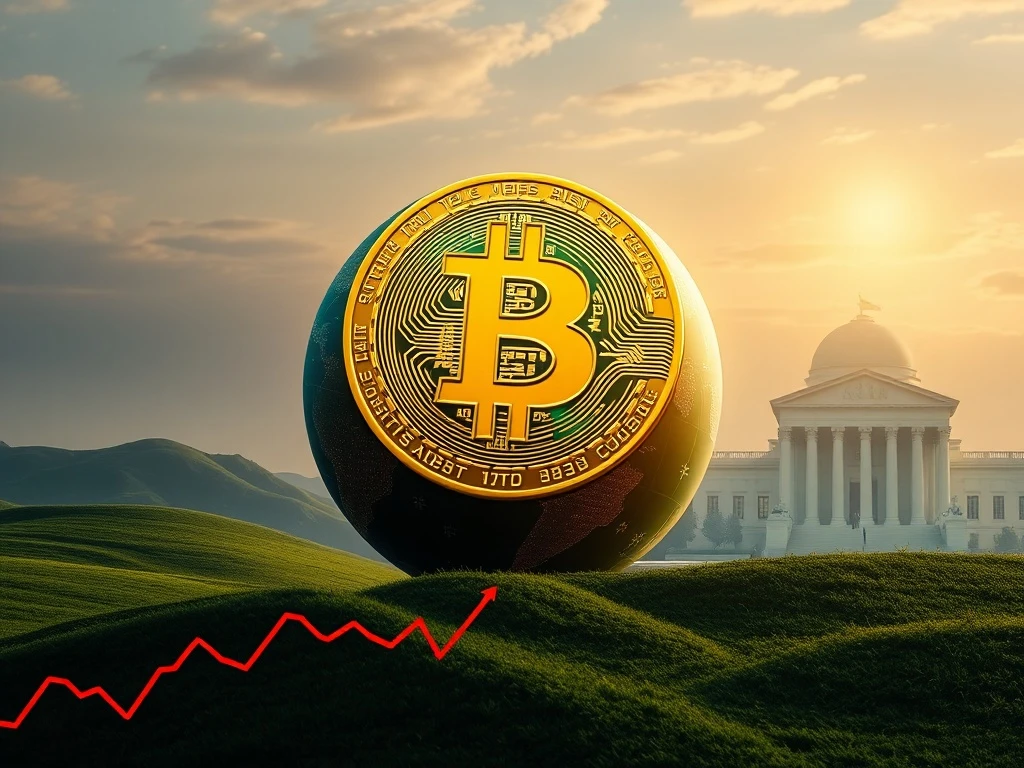In an era defined by shifting economic landscapes, **Bitcoin market share** continues its remarkable ascent. The digital asset has carved out a significant portion of global money, reaching approximately 1.7% just before the United States Federal Reserve signaled potential interest rate cuts. This impressive growth highlights Bitcoin’s increasing relevance as a store of value and a hedge against traditional financial volatility, capturing the attention of business leaders and entrepreneurs worldwide.
Understanding Bitcoin’s Expanding Global Footprint
Bitcoin (BTC) has steadily grown its presence in the global financial system. Recent data from River, a Bitcoin financial services company, reveals a significant milestone. Bitcoin now accounts for roughly 1.7% of the total global money supply. This figure encompasses a broad spectrum of assets, including the aggregate M2 money supply data for all major fiat currencies, various minor currencies, and even gold’s market capitalization.
River’s analysis offers a compelling perspective. The company weighed Bitcoin’s market capitalization against a substantial $112.9 trillion basket of fiat currencies. Furthermore, it considered $25.1 trillion in hard money, specifically excluding silver, platinum, and other exotic metals like palladium. This comprehensive comparison provides a clear picture of Bitcoin’s growing financial weight.
At its peak in August, Bitcoin’s market capitalization surpassed $2.4 trillion. This valuation directly contributed to the 1.7% figure. However, market dynamics are fluid. As of this writing, BTC’s market cap stands at approximately $2.29 trillion. Consequently, its total share of global money adjusts slightly to about 1.66%. Nevertheless, this sustained high percentage underscores Bitcoin’s enduring strength and its increasing **Bitcoin market share**.

Bitcoin market cap compared to global money. Source: River
Central Bank Policies and the Rise of Hard Money Alternatives
The continuous expansion of central bank balance sheets plays a pivotal role in Bitcoin’s increasing valuation. Around the world, central banks have engaged in extensive money printing. This practice often leads to a reduction in the purchasing power of fiat currencies. Investors, therefore, seek out alternatives that offer stability and long-term value. Consequently, assets like Bitcoin and gold continue to claim a greater share of the global money pie.
This trend is not new. Historically, gold served as the primary hedge against inflation and currency devaluation. However, Bitcoin has emerged as a digital counterpart, often referred to as ‘digital gold.’ Its decentralized nature and fixed supply cap of 21 million coins make it an attractive option. Many perceive it as a superior store of value compared to traditional fiat currencies, which are susceptible to inflationary pressures.
The economic environment fosters a growing appetite for such assets. As central banks maintain accommodative monetary policies, the appeal of assets with scarcity grows stronger. This fundamental economic principle directly contributes to the expansion of **Bitcoin market share** within the broader financial ecosystem.
Federal Reserve Signals: A Catalyst for Bitcoin’s Surge
The recent pronouncements from the United States Federal Reserve have significantly impacted the cryptocurrency market. Federal Reserve chairman Jerome Powell delivered a key address at the Jackson Hole Economic Symposium in Wyoming. His speech on Friday signaled impending interest rate cuts and indicated a continuation of monetary expansion.
Powell’s remarks provided critical insights into the Fed’s policy stance. He stated, “Our policy rate is now 100 basis points (BPS) closer to neutral than it was a year ago. The stability of the unemployment rate and other labor market measures allows us to proceed carefully as we consider changes to our policy stance.” This statement implies a more dovish approach, suggesting that the era of aggressive rate hikes may be winding down.
The market reacted swiftly to these signals. The price of Bitcoin surged by over 2% immediately following Powell’s speech. It reached a price of approximately $116,000 per BTC on Friday. This direct correlation highlights how central bank decisions profoundly influence the valuation of digital assets, further solidifying the narrative around **Bitcoin market share** growth.

Federal Reserve chairman Jerome Powell delivers keynote address at the Jackson Hole Economic Symposium. Source: Kansas City Fed
Market Reaction and Investor Confidence
The response from the cryptocurrency market to the Fed’s dovish signals was overwhelmingly positive. Bitcoin and other digital assets typically appreciate during periods of monetary expansion. This is because the price of digital assets often correlates with global liquidity levels. When central banks inject more money into the economy, investors tend to allocate capital towards riskier, higher-growth assets, including cryptocurrencies.
Investor sentiment has also shifted notably. Data from the Chicago Mercantile Exchange (CME) Group indicates strong expectations for future rate adjustments. A significant 75% of investors now anticipate an interest rate cut of 25 basis points in September. This widespread expectation further fuels optimism within the crypto community. The broader crypto sentiment has consequently returned to a state of ‘Greed,’ as indicated by various market indices, following the spikes in both Bitcoin and Ether prices.
This environment creates fertile ground for continued growth. The anticipation of lower interest rates makes holding cash less attractive. Therefore, investors often seek higher returns elsewhere. This shift in capital allocation naturally benefits assets like Bitcoin, reinforcing its position and contributing to its expanding **Bitcoin market share**.
Expanding Adoption and Future Outlook for Bitcoin
Beyond institutional and macroeconomic factors, the adoption of Bitcoin is also broadening across different demographics. For instance, a notable trend shows that baby boomers, who collectively hold an estimated $79 trillion in wealth, are increasingly engaging with Bitcoin. This demographic shift signals a mainstreaming of the digital asset. It moves beyond early adopters and into more traditional investment portfolios.
The long-term outlook for **Bitcoin market share** appears robust, especially if global monetary expansion continues. As central banks navigate complex economic challenges, the role of decentralized, finite assets like Bitcoin becomes more pronounced. Many analysts believe Bitcoin will continue to serve as a crucial hedge against inflation and economic uncertainty. Its inherent scarcity and censorship resistance make it an attractive asset in an unpredictable world.
Ultimately, Bitcoin’s journey from a niche digital experiment to a significant component of global money is a testament to its resilience and growing acceptance. Its ability to absorb market liquidity and attract diverse investor groups underscores its evolving role. The digital currency is not just a speculative asset but an increasingly vital part of the global financial fabric.
Frequently Asked Questions (FAQs)
1. What does Bitcoin’s 1.7% share of global money signify?
Bitcoin’s 1.7% share of global money indicates its significant growth and increasing acceptance as a legitimate asset class. It shows how Bitcoin is gaining ground against traditional fiat currencies and hard money like gold, becoming a notable part of the world’s financial landscape.
2. How do central bank policies influence Bitcoin’s value?
Central bank policies, particularly those involving money printing and interest rate adjustments, significantly impact Bitcoin’s value. When central banks print more money, it can lead to inflation, reducing the purchasing power of fiat currencies. This drives investors towards scarce assets like Bitcoin, which acts as a hedge against inflation. Lower interest rates also make holding cash less attractive, pushing capital into assets like Bitcoin.
3. What was the impact of Fed Chair Jerome Powell’s recent speech on Bitcoin?
Fed Chair Jerome Powell’s recent speech, signaling impending interest rate cuts and continued monetary expansion, had a positive impact on Bitcoin. The price of Bitcoin surged by over 2% immediately after his remarks. This reaction demonstrates the market’s expectation that a more dovish monetary policy will increase global liquidity, which often benefits digital assets.
4. Why is Bitcoin often referred to as ‘digital gold’?
Bitcoin is often called ‘digital gold’ because, like gold, it possesses qualities of scarcity and serves as a store of value. Both assets are seen as hedges against inflation and economic instability. Bitcoin’s fixed supply cap of 21 million coins mimics gold’s limited supply, making it an attractive alternative in a world of depreciating fiat currencies.
5. How does increasing Bitcoin market share affect its long-term outlook?
An increasing Bitcoin market share suggests a strengthening long-term outlook for the digital asset. As more capital flows into Bitcoin and its adoption broadens across different investor groups, its stability and legitimacy grow. This trend reinforces its potential as a significant global financial asset, capable of weathering economic uncertainties and providing a robust alternative to traditional investments.














